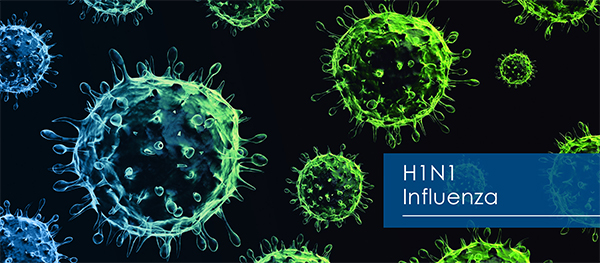Influenza viruses belong to the Orthomyxoviridae family and cause the majority of viral lower respiratory tract infections.
In 2009, a strain of influenza A (H1N1) virus contains sequences of avian, swine and human influenza emerged and spread across the world causing influenza pandemic.

This virus known as A (H1N1)pdm2009 virus, Influenza A (H1N1)2009 or (H1N1)v, has been widely circulating across the globe since then, and is now established in human populations as a seasonal influenza virus. Influenza A and B are a significant cause of morbidity and mortality worldwide, considering that elderly and compromised individuals are especially at risk of developing severe illness and complications such as pneumonia.
After an incubation period of one to two days, the illness has an abrupt onset. People feel some or all of these symptoms: fever or feeling feverish/chills, cough, sore throat, nasal stuffiness and discharge, myalgia, headaches, and anorexia. The influenza viruses can be spread from person to person in two different ways: through the air (large droplets and aerosols from sneezing and coughing), and by direct or indirect contact. Wild waterfowl are believed to be the natural reservoir of influenza A viruses, which can transmit the virus to numerous other species, primarily poultry, pigs, and humans.
Available test for the diagnosis of H1N1 virus are:
Certest Rapid Test:
- Influenza A
- Influenza A + Influenza B
- Influenza A + B + RSV
- Influenza A + Influenza B + RSV + Adenovirus Resp.
- SARS-CoV-2 + Flu A
- SARS-CoV-2 + FluA + FluB
- SARS-CoV-2 + FluA + FluB + RSV
VIASURE Real Time PCR Detection Kits:
- Influenza (H1N1)
- Influenza A
- Flu A + Flu B
- Flu A, Flu B & RSV
- Flu Typing I (H1N1 & H3N2)
- Flu Typing II (H1N1, H5N1, H3N2 & H7N9)
- Flu A, Flu B & SARS-CoV-2
- Respiratory Panel I
- Respiratory Panel II
- Respiratory Panel III
- Respiratory Panel IV
Certest bioSCIENCE (for Influenza A detection):
